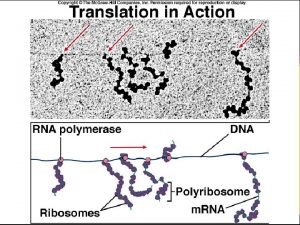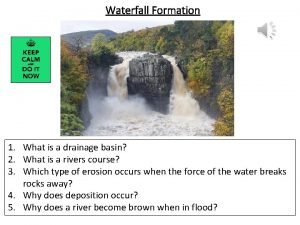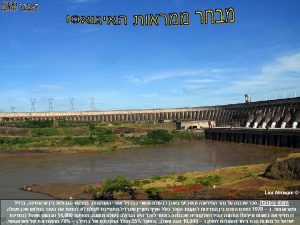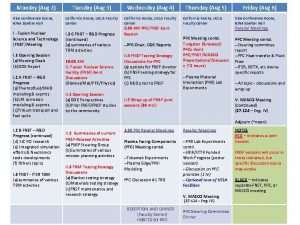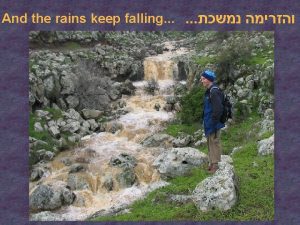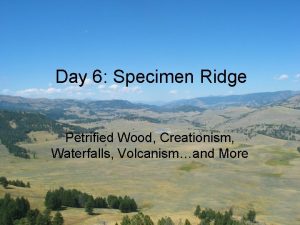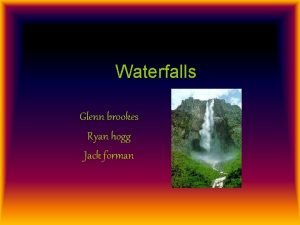Swifting Up high and under waterfalls Aug 1







- Slides: 7

“Swifting”: Up high and under waterfalls Aug 1 -5 2015 I now know with certainty that searching for Black Swifts, or “swifting” is not for the faint of heart. The sheer beauty of their waterfall habitat alone causes palpitations, not to mention the bear-country bushwhacking, miles of paddling, dead-fall trapeze, slippery creek -bed navigation, scree-slope rock skiing, and night-time navigation. I‘d be better off if I were a professional mountaineer, but I’m not so have to rely on my obsession with these elusive gems of the bird world just to get to where I will maybe see one. But, heading into Glacier National Park this August I was eager not only to see Black Swifts but to confirm breeding at one of six known waterfalls within the park; and maybe even find a new breeding site. Photos: (top) Feather Woman Falls , the 6 th known nesting site in Glacier; Paul Bjornen far right. (left), Katie Bjornen at the falls; (above), close up of falls above Avalanche Creek

Feather Woman Falls, high up on the shoulder of Sperry Glacier Trail, plunges impressively into a field of scree and large rubble below, topping out around 7, 050 ft. The view is expansive and rolls out over Sprague Creek, the forest below, and seven miles towards the hidden glimmer of Lake Mc. Donald. Nearby wildfires shroud everything in haze. Last year, we added this site to the state’s small but growing database of locations known to have Black Swift activity. To think it took so long to find this location and all the while it Photos: (above) Feather Woman Falls above Sperry Trail and the scree field below; (left) View looking west towards Lake Mc. Donald along Sprague Creek. was right off the Sperry Glacier trail. Last year I was amazed to speak to a life-time Glacier enthusiast who, during 50 years of trekking in the park, never once laid eyes nor ears on the species. He couldn’t believe he’d missed such a thing, and vowed to keep a closer watch. But then again, you can’t blame him for missing the Black Swift – it was one of the last species described in North America. Another reason he’s probably never seen the bird is because when swifting, there is no multitasking allowed. The advice I was given my first trip

someone is looking; they are really fast, you just don’t want to look away. While there are occasional observations of groups of Black Swifts feeding and circling over the large lakes in the park, watching for them at a nest site is different. This year I trekked with two others, Paul and Katie Bjornen, who admittedly did not know what they were in for. But I was confident they were right for the job, as the proved to be. As a team, Paul Katie and I posted up around the falls around dusk, each with a unique view of the falls. We each tried to get as much sky-view overhead as possible, for a better chance at silhouetting a black shape entering the falls. We scanned the waterfall’s many pockets, shelves and crevices for the telltale sign of whitewash on the rocks. We found some, but only with difficulty were able to discern it from the whitish-grey lichen. Nevertheless, its presence raised the hair on my neck, because I hadn’t seen any sign last year. In short order, the vigil was on. Almost an hour and a half in, at 8: 20 pm, Paul hollered over the waterfall roar that he had seen one enter, right where we expected it. Bingo! We had a nest! In fading light, we focused the spotting scope deep into one of the darkest recesses in the falls, and then we saw a nestling (See the red circle below and zoomed in photo showing the mossy nest cup)! Ecstatic is the word, and fun, and a researchers dream. We watched the adult fly in and out and cling to the wet rock walls, tending its one chick. Other birds flew close to the base and rock overhang of the falls raising the suspicion that there are more nests here. After two days of surveys we came away believing the site could contain up to four nests, not uncommon for this communal-nesting species.

The next assignment was less clear cut. I joined park biologist Lisa Bate to explore waterfalls far up the North Fork of the Flathead, past Logging Lake, past Grace Lake, between the two lakes, and further, to an unnamed falls that looked just right. It was one of those trips. Hike six miles, paddle seven miles, hike two miles, hike down the creek, hike up the lake, hike up and over all those stinking logs and Devil’s club, rinse and repeat. We were staying at the head of Logging lake at night, and a chorus of birds, from Pygmy owls to Belted Kingfishers was captivating. The wails of the loon rose high above, until joined by an eerily similar howling of wolves. (Above) Logging Lake – a great site for birds of all types including loons. (Above) Grace Lake – above Logging Lake, and one lake closer to the falls. (Above) The head of grace Lake with falls (not visible) present high up near the saddle.

(Below) Falls above Grace Lake – our objective - everywhere we looked we saw more falls (Below) Lisa Bate hikes between Grace and Logging Lake looking for rumored falls We were following the water, that was for sure, but we were also following advice of fish biologists working in the area to restore native trout. They were telling us juicy tales of hidden waterfalls, huge waterfalls, waterfalls we couldn’t figure out how to get to,

Between Grace and Logging Lake we found a 40’ waterfall – good intel from “fish guys”. It seemed to open up out of nowhere, and was framed by thick forest and bramble on both sides. There was a lot of water. Maybe too much? But there were so many pockets available to a nesting bird. We had to resign to survey the site by day – not sure how to actually access this site again by night. (Above) Falls between Grace and Logging Lake; (Below left) Lisa scoping the falls above Grace Lake; (Below right) Selfie of Lisa and I at the head of Grace Lake – falls way in the background. We also know what is meant by “the falls above Grace Lake” – at least a dozen segmented, plunging, and highly featured falls poured down towards us. They all looked great for swifts, and professional mountaineers. How the heck do we survey here, at night? It’s a very real question we are going to have to figure

leave a swift survey before it starts, because of bad weather, bad timing, or plain reality, is never easy, and we headed back to camp a bit weary. We schemed for next year. Should we try to get our geared packed in? I had gotten warm after putting on my raincoat so I stopped to “oh my gosh overhead, swifts!” At least two Black and two Vaux’s Swifts circled, probably for insects stirred up by the incoming weather. That was all we had wanted to know. Success. Relief. Reward. We will be back next year. This year’s journey to Glacier was fruitful, and all of the sites we visited, including Avalanche Falls (a series of six below), merit (Top Right) Amy Seaman paddling down Logging Lake; ( Middle Right) Aaron Spidal , shown below another work. I am Avalancheyear’s Lake, surveyd Avalanche fallsglad. with me and saw two birds, well saw two streaks at least! I know there is swifting to be had in the future.






